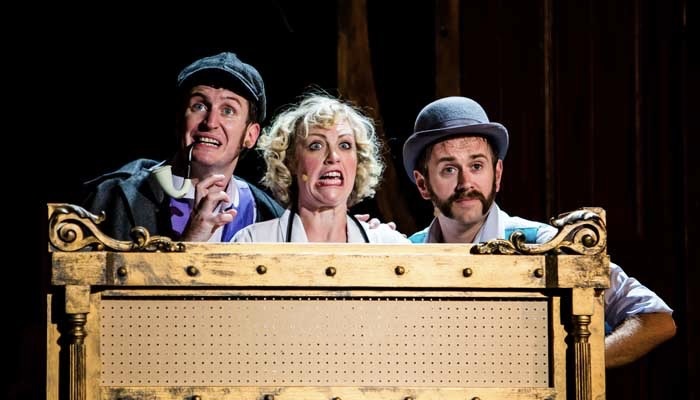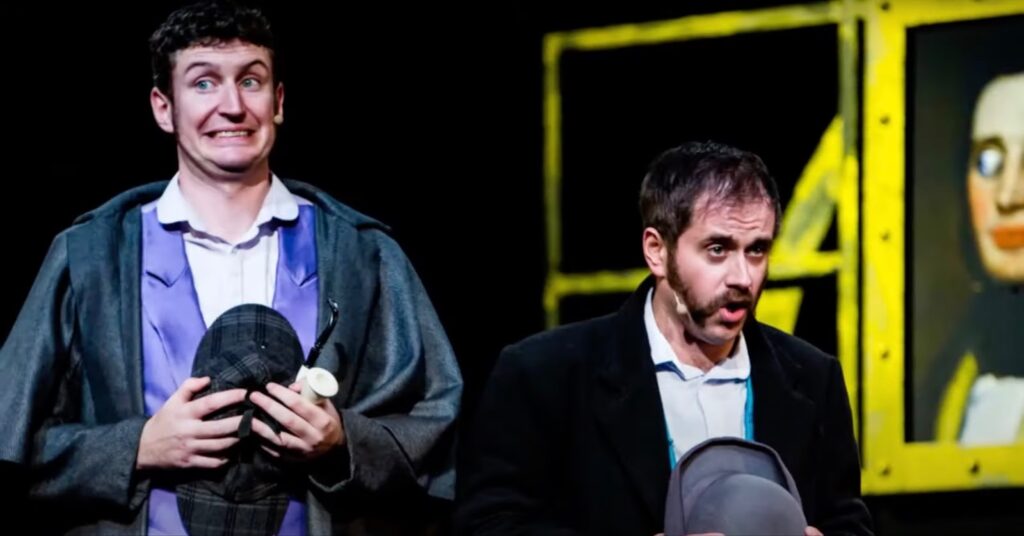
Dive into Potted Sherlock: Audience Acclaim Since Premiere
The curtains rose to reveal a stage set for adventure and mystery, signaling the birth of ‘Potted Sherlock.’ This production was not merely a play; it was a celebration of one of literature’s most enduring figures. The anticipation in the theater was palpable, as Sherlock aficionados and novices alike waited with bated breath. The ensemble, tight-knit and buzzing with energy, embarked on an ambitious quest: to distill the essence of Sherlock Holmes into a single evening’s performance. The result? A whirlwind tour de force that whisked the audience away on a journey across fog-laden London to the hallowed halls of 221B Baker Street, and beyond.
Critical Acclaim: The Reviews Are In
In the wake of the premiere, the morning papers and digital platforms were ablaze with reviews. Critics, armed with their notepads and pens, found themselves enthralled:
- The Times: “A theatrical concoction that’s both heady and exhilarating…”;
- The Guardian: “Potted Sherlock leaves you gasping for more—more laughs, more twists, more sheer energy…”
The accolades were many, with reviewers tipping their hats to the creativity on display. Here’s a snapshot of the critical reception:
| Source | Rating | Highlight |
|---|---|---|
| The Independent | 4.5/5 | “A triumph of theatrical wit and narrative ingenuity.” |
| Variety | “Must-See” | “A marvel of pacing and comedic timing.” |
| The Stage Review | 4/5 | “Holmes and Watson reborn in a riotous new avatar.” |
A Study in Theatrics: Cast and Character Interplay
When dissecting the success of ‘Potted Sherlock,’ one must give kudos to the cast. The ensemble was small but mighty, with each member donning multiple hats—quite literally—as they slipped in and out of the manifold characters from the Holmesian lore. Their interplay was the fulcrum on which the production tilted, a perfectly balanced scale of drama and comedy. The chemistry was electric; their timing, impeccable. The cast’s cohesion was a testament to their skill and the director’s vision. Each portrayal was a vivid brushstroke painting a complex picture of Victorian intrigue and timeless human emotions.
Innovative Direction: Behind the Scenes Genius
At the helm was a director whose vision for ‘Potted Sherlock’ was clear: to revitalize the canon stories for a contemporary audience without stripping them of their soul. The direction took bold risks: imagine a Sherlockian universe set to the rhythm of modern humor, yet the vintage charm of Doyle’s tales was preserved immaculately. This was storytelling that was unafraid to tread new ground, to mingle the sacrosanct with the irreverent, creating a pastiche as delightful to the purists as it was to the uninitiated.
Audience Engagement: The Laughter and Applause Ratio
The best barometer for the play’s success was the audience’s reaction. Laughter, the universal music of enjoyment, rippled through the theater with each well-timed joke and witty repartee. The applause was fervent and frequent. But let’s quantify this, shall we? Observers noted:
- Laughs per minute: an average of 5—a high for stage productions;
- Applause breaks: over 10, indicating peak engagement;
- Standing ovations: consistently observed across performances.

The Set Design: Victorian Aesthetics Reimagined
The set was a character in its own right: an embodiment of Victorian aesthetics with a dash of whimsy. It was clear that the set designer played a game of ‘less is more,’ allowing the audience’s imagination to fill in the blanks. A clever use of props and backdrops transported the audience across multiple settings—a testament to the ingenuity of the design team.
Here’s how the set evolved scene by scene:
- Baker Street: Simple yet iconic, the famed detective’s study was realized with strategic clutter and period props that hinted at the genius of Holmes;
- London Streets: Fog machines and cobblestone backdrops painted a picture of the mysterious city;
- Moorlands: With strategic lighting and sound effects, the stage transformed into the open moorlands, haunting and wild.
Scriptwriting Brilliance: The Quips and Twists
The script was a deftly woven fabric of Doyle’s narrative threads, each line a homage to the classic and yet remarkably fresh. The writers struck a delicate balance, ensuring that each quip and jest landed with precision while the story’s heart kept beating strong. The dialogue was a firework display of linguistic flair, a melding pot where archaic turns of phrase met modern-day colloquialisms to delightful effect.
Music and Score: An Auditory Accompaniment
The play’s score was a character that never took physical form but was as vital as Holmes and Watson themselves. The music carried the audience along, an emotional undercurrent that underscored every revelation and every moment of levity. From the tense violin strings mimicking the thrill of the chase to the somber notes accompanying moments of deduction, the score was a masterclass in how music could elevate narrative.
Costuming and Props: Detailing the Detective
The devilish detail in ‘Potted Sherlock’s’ costuming and props cannot go without mention. Every fabric fold, every accessory, was meticulously chosen to reflect the characters’ essence as well as the era’s style. The deerstalker cap, the pipe, the magnifying glass—each prop became an extension of the characters, imbuing them with an authenticity that transcended the stage.

The Societal Impact: Beyond the Stage
What happens on stage doesn’t stay on stage. ‘Potted Sherlock’ spilled over into the zeitgeist, becoming a touchstone for discussions around adaptations and the enduring appeal of detective fiction. It inspired amateur sleuths and professional playwrights alike, reigniting a collective appreciation for the genre and its potential for reinvention.
Sustaining Interest: Longevity in the Public Eye
Several years since its first bow to the audience, ‘Potted Sherlock’ has remained a vibrant part of the conversation. The play’s longevity is a rare feat in a world of fleeting entertainment. Let’s chart its trajectory:
- Yearly Ticket Sales: Steady with seasonal spikes, indicating returning patrons and new interest;
- Social Media Mentions: A consistent uptrend, with peaks around show anniversaries;
- Cultural References: Referenced in pop culture, demonstrating its impact.
“Pretty Red Dress” and “Potted Sherlock”: Intersecting Paths of Storytelling
The realm of storytelling is vast and diverse, often bringing different narratives into conversation with each other in unexpected ways. Such is the case when one considers the juxtaposition of “Potted Sherlock” with the 2023 film “Pretty Red Dress,” directed by the talented Dionne Edwards. At first glance, these two creative works might seem worlds apart—one, a witty stage rendition of classic detective tales; the other, a poignant cinematic piece that unfolds within the vibrant, multifaceted world of contemporary London.
Yet, upon closer inspection, there are intriguing parallels to draw:
- Setting as a Character: Both works employ London as a backdrop, but they showcase the city’s different faces. “Potted Sherlock” revels in the foggy, cobblestoned streets of the Victorian era, while “Pretty Red Dress” captures the pulsating, diverse metropolis of today;
- Storytelling Techniques: Dionne Edwards, in “Pretty Red Dress,” uses color and costume—a stunning red dress—to tell a story of identity and transformation, much like the iconic deerstalker hat and pipe in “Potted Sherlock” serve to immediately identify the legendary detective;
- Narrative Structure: “Potted Sherlock” ambitiously encapsulates multiple stories within a single performance, while “Pretty Red Dress” weaves together personal narratives, showing how interconnected lives intersect in a modern city.
To visualize the thematic crossovers, consider the following table:
| Element | “Potted Sherlock” | “Pretty Red Dress” |
|---|---|---|
| Setting | Victorian London | Modern-day London |
| Symbolism | Deerstalker Hat & Pipe | The Red Dress |
| Themes | Mystery, Adventure, Intellect | Identity, Family, Transformation |
| Narrative Style | Pastiches of Classic Stories | Interwoven Contemporary Tales |
Conclusion
In conclusion, ‘Potted Sherlock’ is an artistic gem that shines brightly in the firmament of theatrical productions. From its innovative direction to its engaging script, impeccable acting, and resonant musical score, the show stands as a beacon of creativity and a blueprint for how to bring classic tales to life in new and exciting ways. It has, undoubtedly, carved its name in the annals of stage history and in the hearts of its viewers.